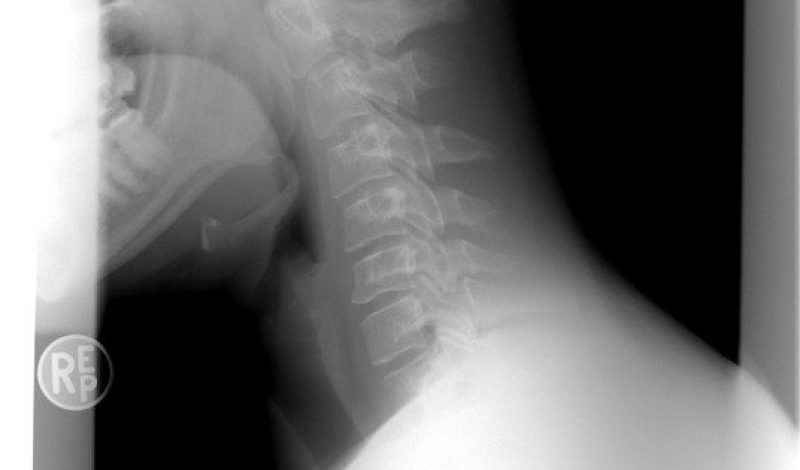The Cervical Spine
Your neck itself is otherwise known as the cervical spine. There are seven vertebrae in your neck, all of which help to hold up your head and these bones are called C1 to C7 depending on the level of the vertebrae.
The structure of the spine
C1 is at the top of the neck and C7 is at the base of the neck. There are vertebral discs located between each vertebra in the neck, except between the levels C1 and C2 where one bone simply rotates and moves upon the other, aided by a pair of joints.
The top two vertebrae in your neck also have individual names other than C1 and C2; these names are ‘Atlas’ and ‘Axis’. Because C1 sits on top of C2, it is also called the Atlas bone. This is derived from old Greek mythology. Atlas was one of the Titans and as punishment he was tasked to hold up earth’s sky for all eternity (or in our case the skull itself!). The vertebrae below this is called C2 or ‘Axis’. The reason why it is called the Axis, is because of its shape. The C2 vertebra, has what is called an odontoid process, this is like a bony pillar that the C1 vertebra can rotate around, hence the name Axis.
Spinal Nerves and Spinal Cord
In between the vertebrae in your neck you have what is call an intervertebral foraman (IVF) which is an opening on either side of your neck at each level. Through these holes, your spinal nerves exit the spine, which originate from the spinal cord itself, whilst the spinal cord continues further down through a separate channel. Your spinal cord is what connects your nervous system to your brain via your brainstem. The neck is rather unique in that we have seven cervical vertebrae, but eight pairs of cervical spinal nerves!
Each spinal nerve that is located within the neck, originates from two ‘roots’ which emerge from the spinal cord itself. Once these then join together, they collectively are then referred to as the spinal nerve. The two roots are referred to as ‘dorsal’ and ‘ventral’ roots, meaning front and back. Ventral roots carry motor signals to muscles and control the resting tone of a muscle, and the dorsal roots carry information regarding sensation types: soft touch, sharp, hot and cold sensations.
Spine problems
If there is a problem with the ventral root, then there may be symptoms that relate to muscle weakness, twitching within a muscle (called fasciculations) or difficulties performing certain movements, such as gait (if your lower back is affected or gripping objects and finer hand movements if your neck is affected). Problems with a dorsal root can present as numbness, tingling, or an overly sensitive area in the shoulder, arm, hand or fingers if the neck is affected (or a combination of these).
Certain spinal nerves typically provide nerve supply to certain muscle groups and a certain area of skin and tissue within say- an arm if it originates from the neck. Although there is some variation amongst the population, we as chiropractors at Skelian will examine each area of the body, and uses this information to look at which muscle involvement or area of pain/sensation change correlate to which corresponding nerve.
The nerves exiting the neck are also numbered like your vertebrae are numbered, and those nerves numbered C5-C8, alongside a nerve from the top of your upper back called T1, merge to form a complex network of nerves in the shoulder region in what is called the brachial plexus. This network of nerves travel from your neck and upper back, through your shoulder and down your arm. Stemming from the brachial plexus itself, there are then three distinct nerves than branch into the arm which are called your radial, median and ulnar nerves.
If you are struggling with neck pain, or having shoulder or arm pain, as chiropractors we might be able to help with your symptoms if the problem is appropriate for chiropractic care. Each initial consultation includes a detailed medical history and a thorough physical examination in order for us to help identify where the problem is arising. Once we have established the most likely cause of your complaint, known as a ‘working diagnosis’ we can work out a plan to address the symptoms through chiropractic care or recommend other forms of appropriate treatment. In forming this plan we may require further medical imaging such as X-ray or MRI, depending on the specifics of your case, however sometimes we will formulate a treatment plan without an immediate need for this.
If you would like further information or would like to book an apointment please call 01242 25400 or email stpauls@skelian.co.uk.
References
https://www.greekmythology.com/Titans/Atlas/atlas.html
https://www.greekmythology.com/Titans/titans.html
https://www.physio-pedia.com/Axis
https://www.spine-health.com/conditions/spine-anatomy/cervical-spinal-nerves
https://emedicine.medscape.com/article/1877731-overview
https://orthoinfo.aaos.org/en/diseases–conditions/brachial-plexus-injuries/
Links
https://www.instagram.com/skelian_chiropractic/
https://www.facebook.com/skelianclinic/
https://www.youtube.com/channel/UCCJ9BXYUAAfOie7zTUUeIKA/videos



